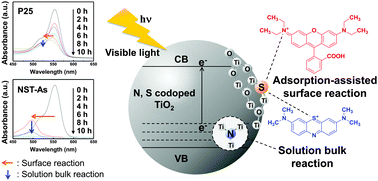Adsorption-assisted photocatalytic activity of nitrogen and sulfur codoped TiO2 under visible light irradiation†
Abstract
Applying post thermal treatment on the doped TiO2 at high temperature is mostly regarded as an indispensable process, although it has negative effects on the photocatalytic activity of doped TiO2. Herein, we synthesized the N- and S-codoped TiO2 (NSTs) with an anatase phase using a simple solvothermal treatment and investigated their visible light photocatalytic activity associated with the thermal behavior of dopants in NSTs. We found that the as-synthesized NST (NST-As) has better visible light photocatalytic activity and adsorptivity than the commercially available P25 and the thermally treated NSTs. The S dopants effectively assist the surface reaction by adsorbing cations of organic dyes on the NST-As surface. The N dopants increase the absorbance at visible light region of NST-As by forming a delocalized state at the band gap of NST-As. However, the photocatalytic activity of NSTs gradually weakens with the post thermal treatment, because S dopants on the NST-As surface are transformed from sulfide to sulfate during the thermal treatment and N dopants move out during the crystallization of TiO2. The adsorption-assisted photocatalytic activity of NST-As under visible light irradiation is an attractive feature for environmental and photonic technologies.


 Please wait while we load your content...
Please wait while we load your content...